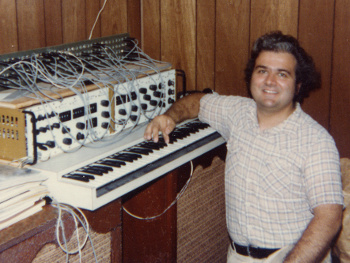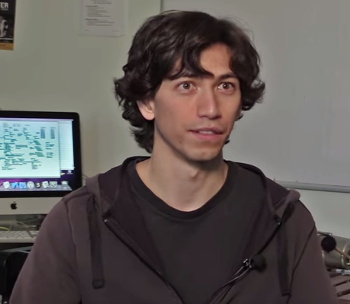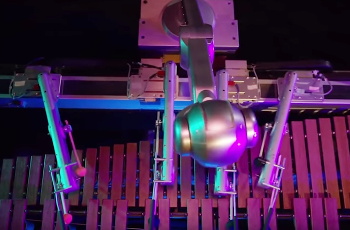Robot Musicians
July 10, 2017
Many
decades ago, long before the advent of
ubiquitous computing and today's
miraculous artificial intelligence systems, I was a
freshman college student taking an "introduction to music"
course. The
textbook, "The Enjoyment of Music," was written by Joseph Machlis, a
professor of
music at
Queens College of the City University of New York. Although Machlis is
deceased, the book is still revised by a team of
authors.[1]
As could be expected from a book intended for
non-musicians, the book was light on
music theory and heavy on
music history. One course requirement was to write a
review of an
orchestral concert, and another was to write a
term paper. I wrote mine on
electronic music. At that time, electronic music was generally produced by
analog means, such as modification of
recorded natural sounds (
Musique concrète). In that age of
engineering students carrying boxes of
punched cards around
campus, I
speculated in my paper that
computers would one day
compose their own music.

A Portrait of the Artist as a Young Man.
Author, circa 1980, with an analog synthesizer of his own design)
Quite a few years after that, in 1985, I was in conversation with the
husband of my
son's piano teacher. He was a noted
violinist, I was
experimenting with
computer music, and we had a lively conversation about musicians eventually being replaced by
automation. He argued that a machine couldn't reproduce the special
acoustic nuances of
professional musicians; and I, having taken a short course in
neural networks, said that a machine could do just as well when given enough examples.
Automation of music was an important topic at that time, since orchestras for
Broadway musicals were shrinking. The culprit was the
electronic music synthesizer, by which a single musician could replace an entire orchestral section, such as
strings or
brass. The
musician's union was quite upset about this, and this was a
harbinger of what is now happening in many other professions.[2-3]
Translating
pseudorandom numbers into
musical notes will produce something worse than any
twelve-tone composition, but there's one simple technique that produces adequate results. A
Markov chain produces random samples that depend on their recent history, and it can produce random samples with a particular
probability distribution. One popular application of Markov chains is the generation of "
travesty texts," texts that mimic the qualities of particular source material.
The prolific
Brian Hayes published such a generator in a 1983 article in
Scientific American.[4] At the time of his writing, Hayes did not know that he was building on some obscure work by the
Russian mathematician,
Andrei Markov (1856-1922).[5-6] The Markov chain text generation
algorithm, which could be implemented on a 1983
personal computer, can also be applied to musical composition with great success. As they say, "one note follows another," and this technique proves it.
Much later,
David Cope developed advanced techniques for computer music generation.[7-8] An extended list of
references to his papers on his concept of "Recombinant Music Composition" can be found in his
2010 US patent no. 7,696,426, Recombinant Music Composition Algorithm and Method of Using the Same.[9] As the name implies, the technique uses
genetic programming to generate and evaluate musical phrases based on a seed.[7]
In the production of music, we have the
composer, soon to be automated in some cases, then the musicians. Why not automate the musicians, also, to have an instantaneous performance concurrent with the instantaneous composition? While synthesized orchestral instruments have performed computer compositions, this has rarely been done concurrently. While
physical pianos have been modified to perform
digital music, there's not a
robot at a seat banging the
keys with mechanical
fingers.
Now,
researchers at the
Georgia Institute of Technology (Atlanta, Georgia) have created, Shimon, a robot
marimba player with four arms that composes its own music and can listen and
improvise alongside human performers.[10-11] Shimon was created over the course of seven years by
Mason Bretan, a
Ph.D. candidate under
advisor,
Gil Weinberg, director of
Georgia Tech's Center for Music Technology.[11] Shimon uses a
deep learning neural network that takes as an input a two-four
measure-long seed
melody. The neural network has been trained on nearly 5,000 compositions from such composers as
Beethoven,
Lady Gaga, and
Miles Davis.[10-11]

Mason Bretan of Georgia Tech.
(Still image from a Georgia Tech YouTube Video.)
This is the first time a robot based on deep learning has created music, including
harmonies and
chords. Says Breton,
"Once Shimon learns the four measures we provide, it creates its own sequence of concepts and composes its own piece... Shimon's compositions represent how music sounds and looks when a robot uses deep neural networks to learn everything it knows about music from millions of human-made segments."[11]

Portion of a Shimon-created score. (From a Georgia Tech YouTube Video.[13]
As for all neural networks, Shimon's music is very similar to its
training set. If it were fed data from just one composer, its music would sound like another composition of that composer. However, shorter seeds will lead to greater variation in the output, so the music will deviate from the composer's
repertoire to some extent.[10] Also, the level of
look-back is important, and it can range from as few as two measures, to as many as sixteen measures.[10]

Georgia Tech robot marimba player, Shimon.
(Still image from a Georgia Tech YouTube Video.)
Shimon had its
debut at the the
Consumer Electronic Show, but only as a
video clip. It will have its first live performance at the
Aspen Ideas Festival, June 22-July 1, 2017, in
Aspen, Colorado.[11] Students in Weinberg's lab have also created a robotic "third arm" for
drummers.[11] That sounds like an interesting variation on the
old-time one-man band.
References:
- Kristine Forney, Andrew Dell'Antonio, and Joseph Machlis, "The Enjoyment of Music (Shorter 12th Edition," Publisher: W. W. Norton & Company, 504 pp., ISBN-13: 978-0393936384 (via Amazon).
- Alex Witchel, "Replaced By Synthesizer, 'Grand Hotel' Musicians Protest," Chicago Tribune, September 19, 1991.
- Ernio Hernandez, "Musicians Ready to Rally Against Use of "Virtual Orchestra" Machine Off-Broadway," Playbill, April 12, 2004.
- Brian Hayes, "Computer Recreations: A progress report on the fine art of turning literature into drivel." Scientific American, vol. 249, no. 5 (November 1983), pp. 18-28.
- A.A. Markov, "An example of statistical investigation of the text Eugene Onegin concerning the connection of samples in chains," Bulletin of the Imperial Academy of Sciences of St. Petersburg, vol. 7, no. 3 (1913), pp. 153-162. English translation by Alexander Y. Nitussov, Lioudmila Voropai, Gloria Custance and David Link, Science in Context, vol. 19, no. 4 (2006), pp. 591-600, doi:10.1017/S0269889706001074. A PDF file can be found here.
- Brian Hayes, "First Links in the Markov Chain," American Scientist, vol. 101, no. 2 (March–April, 2013), pp. 92-97 .
- Philip Ball, "Artificial music: The computers that create melodies," BBC, August 8 2014.
- David Cope - Emmy Beethoven 2, YouTube Video by David Cope, August 12, 2012.
- David H. Cope, "Recombinant music composition algorithm and method of using the same," US Patent No. 7,696,426, April 13, 2010.
- Evan Ackerman, "Four-Armed Marimba Robot Uses Deep Learning to Compose Its Own Music," IEEE Spectrum, June 14, 2017.
- Jason Maderer, "Robot Uses Deep Learning and Big Data to Write and Play its Own Music," Georgia Institute of Technology Press release, June 13, 2017.
- Robot Composes, Plays Own Music Using Deep Learning, YouTube Video by Georgia Tech, June 14, 2017.
- Robot Composes, Plays Own Music Using Deep Learning (with notes), YouTube Video by Georgia Tech, June 14, 2017.
Permanent Link to this article
Linked Keywords: Decade; ubiquitous computing; miracle; miraculous; artificial intelligence system; freshman; college; student; course; textbook; professor; music; Queens College of the City University of New York; death; deceased; author; musician; music theory; music history; review; orchestra; orchestral; concert; term paper; electronic music; analog electronics; sound recording and reproduction; recorded; natural sound; Musique concrète; engineering; punched card; campus; speculative reason; speculate; computer; musical composition; compose; A Portrait of the Artist as a Young Man; analog synthesizer; design; husband; son; piano teacher; violin; violinist; experiment; experimenting; computer music; automation; acoustic; nuance; professional; artificial neural network; Broadway musical; electronic music synthesizer; string (music); brass instrument; American Federation of Musicians; musician's union; harbinger; pseudorandom number; musical note; twelve-tone technique; twelve-tone composition; Markov chain; probability distribution; parody generator; travesty text; Brian Hayes; scientific literature; publish; Scientific American; Russia; Russian; mathematician; Andrei Markov (1856-1922); algorithm; personal computer; David Cope; reference; Recombinant Music Composition Algorithm; genetic algorithm; genetic programming; composer; piano; digital; robot; musical keyboard; finger; research; researcher; Georgia Institute of Technology (Atlanta, Georgia); marimba; musical improvisation; Mason Bretan; Doctor of Philosophy; Ph.D.; doctoral advisor; Gil Weinberg; >Georgia Tech's Center for Music Technology; deep learning neural network; bar (music); measure; melody; Ludwig van Beethoven; Lady Gaga; Miles Davis; harmony; chord (music); sheet music; score; training set; musical repertoire; retrospective memory; look-back; debut; Consumer Electronic Show; video clip; Aspen Ideas Festival; Aspen, Colorado; drummer; old-time; one-man band.